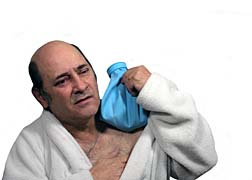Imagine being unable to use your shoulder. Imagine how it would affect your day-to-day life; how even the most simple activities would become incredibly difficult. Think about all the activities you do in a day that involve the use of your shoulder. Getting dressed, washing your face, brushing your teeth, carrying items around your house, lifting up your children (or even just hugging them), cooking food, eating, driving...even walking requires some shoulder activity for balance. Imagine not having enough strength in your arm to pick up a pile of clothing to put it away.
 Now imagine how your work life would be affected if you could not use your shoulder. Even something as seemingly simply as typing on a computer would become too painful. So would talking on the phone, doing any sort of construction work, any work that involved physical activity or lifting and any work that involved writing. When even the most minute shoulder movement causes pain, every activity becomes a monumental task.
Now imagine how your work life would be affected if you could not use your shoulder. Even something as seemingly simply as typing on a computer would become too painful. So would talking on the phone, doing any sort of construction work, any work that involved physical activity or lifting and any work that involved writing. When even the most minute shoulder movement causes pain, every activity becomes a monumental task.This is what patients who use shoulder pain pumps after arthroscopic surgery face if they develop PAGCL. The shoulder pain pumps have been linked to PAGCL, a condition in which the cartilage in the shoulder joint wears down making movement more and more painful. Eventually, patients can get to the point where their shoulder hurts even when they are not moving it.
What makes the condition even more devastating is that the surgery the patients were having in the first place was designed to help them with shoulder problems. Unfortunately, in some cases the pain pump is causing even more severe shoulder conditions than the initial problem the surgery was meant to treat.
The pain pump is given to patients following surgery to help them manage their pain. They use the pain pump for two to three days and can develop PAGCL between three and 12 months following use of the pump. Many patients require complete shoulder replacement surgery and still suffer from lifelong shoulder problems.
Some critics of the pump are urging doctors not to use them until the full extent of their risks is known. One study, published in the July 2007 issue of The American Journal of Sports Medicine, found that 64% of patients who used shoulder pain pumps developed PAGCL. Unfortunately, because the results of the study have not been widely publicized, many doctors still use the pain pumps not realizing the damage they can cause. Some patients have even used the shoulder pain pump on both shoulders, not knowing that they ran the risk of developing PAGCL in both shoulders.
READ MORE LEGAL NEWS
Pain pumps are also used in other areas of the body following surgery; however, it is not yet known exactly what negative effect the pain pump has on other joints, such as the knees or hips. What is known is that for some reason, the cartilage in the shoulders of people who use pain pumps is at risk for being broken down, making movement of that joint incredibly painful, if not impossible.
Patients who have used shoulder pain pumps and experience grinding, clicking, popping or other unusual sensations in their shoulders should seek medical attention.
Lawsuits are now being filed against companies who manufacture shoulder pain pumps, including Stryker, DJO Inc., I-Flow Inc. and BREG.
